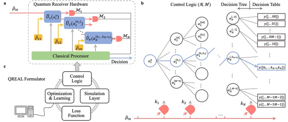Home > Press > Quantum receiver enhanced by adaptive learning
 |
| a, the hardware of a general quantum receiver composed of N rounds of processing. The jth processing round entails a variational quantum circuit represented by the unitary operation U ̂_j configured by the parameter set α_j, ancillary states ρ ̂_(s_j ), and measurement apparatus M_j. b, the control logic comprised of a decision tree and a decision table. Blue lines show one possible path toward the output. Quantum-receiver output y is determined by the sequence of measurement outcomes, tied to a unique path in the decision tree. c, the QREAL formulator consisting of four modules (clockwise) as one iteration in the learning process. The control logic optimized by the QREAL formulator is compiled and built into the classical processor.
CREDIT by Chaohan Cui, Zheshen Zhang |
Abstract:
The quantum receiver is an elementary component in quantum information processing tasks. It aims to extract necessary information from non-orthogonal quantum states. Due to the nature of shot noise, signals carried by electromagnetic waves show non-orthogonal quantum features after suffering a severe loss, such as during interstellar communication. Therefore, the quantum receiver is the only apparatus to decode these weak signals with an error rate below the shot-noise limit.
Quantum receiver enhanced by adaptive learning
Changchun, China | Posted on December 9th, 2022
However, conventional quantum receiver design is fragile to noise. Additionally, the computational cost of analytically optimizing a suitable decoding logic is colossal. Hence, only a handful of quantum receivers have been designed for decoding basic codes, and their performances are still far from ideal.
In a new paper published in Light: Science & Application, a group of researchers, led by associated professor Zheshen Zhang from the University of Arizona and the University of Michigan, and co-authors have developed a quantum receiver enhanced by adaptive learning technique (QREAL in short). By the concept of reinforcement learning, the upgraded quantum receiver now becomes self-guided and can iterate toward a better performance with the presence of noise.
The QREAL architecture comprises three functional cores: the hardware, the control logic, and the formulator. The hardware is based on a phase-locked Mech-Zehnder interferometer, a superconducting single-photon detector, and a classical processor. As a result, the optimized setup guarantees a record-high overall efficiency of around 85% and robust interference visibility of over 99.7%. Loaded with the control logic, the classical processor handles all the hardware electronics. The control logic contains a decision tree and a decision table for decoding signal lively, which are learned by the formulator through hundreds of iterations of optimization and simulation. Given the model of hardware, a targeted quantum information task, and possible noise sources, QREAL aims to learn a decoding protocol efficiently with an error rate as low as possible.
In the experiments, researchers demonstrated its ability to learn a proper decoding protocol and adapt to noise automatically. The experimental results confirm that the performance improves by around 15% compared to conventional design methods and enjoys a 40% lower error rate than the best classical receiver. For decoding binary phase-shifted keying, QREAL achieves less than a 2% error rate with less than one photon per code, which allows error correction and communication with such a low signal power. They also tested the QREAL in seeking the best protocol for decoding quadrature amplitude modulation signals with six codewords. To the best of our knowledge, this is the first time a quantum receiver showing advantage with an alphabet larger than four.
Since the researcher is no longer needed to pilot the platform, QREAL could be implemented in drone platforms for practical purposes such as Mars missions. Furthermore, due to its improved performance in mitigating noise patterns, the framework of QREAL may also benefit other noisy intermediate-scale quantum platforms. It could become a new paradigm of quantum receiver design. the scientists forecast.
####
For more information, please click here
Contacts:
Yaobiao Li
Light Publishing Center, Changchun Institute of Optics, Fine Mechanics And Physics, CAS
Office: 86-431-861-76851
Expert Contact
Chaohan Cui
University of Arizona, USA
Copyright © Light Publishing Center, Changchun Institute of Optics, Fine Mechanics And Physics, CAS
If you have a comment, please Contact us.
Issuers of news releases, not 7th Wave, Inc. or Nanotechnology Now, are solely responsible for the accuracy of the content.
News and information
![]()
Experimental nanosheet material marks a step toward the next generation of low-power, high-performance electronics December 9th, 2022
![]()
Tin selenide nanosheets enables to develop wearable tracking devices December 9th, 2022
Quantum Physics
![]()
NISTs grid of quantum islands could reveal secrets for powerful technologies November 18th, 2022
![]()
Key element for a scalable quantum computer: Physicists from Forschungszentrum Jülich and RWTH Aachen University demonstrate electron transport on a quantum chip September 23rd, 2022
Possible Futures
![]()
3D-printed decoder, AI-enabled image compression could enable higher-res displays December 9th, 2022
Quantum Computing
![]()
NISTs grid of quantum islands could reveal secrets for powerful technologies November 18th, 2022
![]()
Linearly assembled Ag-Cu nanoclusters: Spin transfer and distance-dependent spin coupling November 4th, 2022
![]()
Novel nanowire fabrication technique paves way for next generation spintronics November 4th, 2022
Discoveries
![]()
Experimental nanosheet material marks a step toward the next generation of low-power, high-performance electronics December 9th, 2022
![]()
Tin selenide nanosheets enables to develop wearable tracking devices December 9th, 2022
Announcements
![]()
Experimental nanosheet material marks a step toward the next generation of low-power, high-performance electronics December 9th, 2022
![]()
Tin selenide nanosheets enables to develop wearable tracking devices December 9th, 2022
Interviews/Book Reviews/Essays/Reports/Podcasts/Journals/White papers/Posters
![]()
Experimental nanosheet material marks a step toward the next generation of low-power, high-performance electronics December 9th, 2022
![]()
Tin selenide nanosheets enables to develop wearable tracking devices December 9th, 2022










